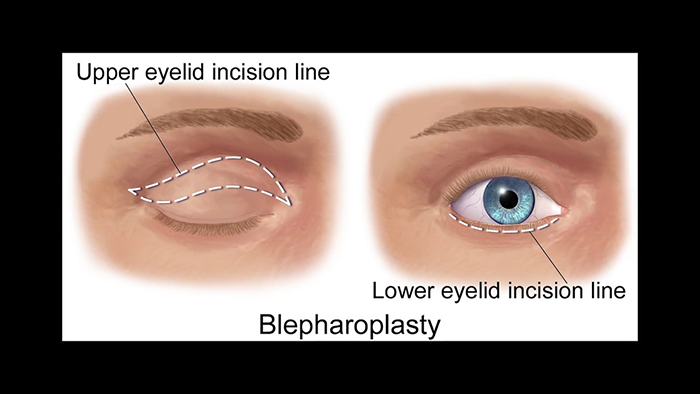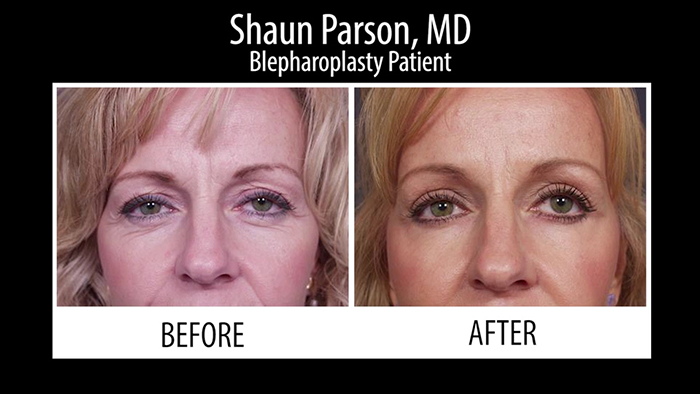When it comes to the impact of our overall expression, no feature can rival our eyes. They communicate without our saying a word. What do your eyes say about you? “Bright”, “alert”, and “rested”? Or, “tired”, “sad”, and “old”? Both age and heredity can play a role in the shape and proportion of your upper and lower lids. You may be beginning to notice your upper eyelid has an overhang, is droopy, or has a hooded appearance. Perhaps your eyes turn down and look sad with frown lines deepening between the brows. Or there may also be puffiness or “pillows” under the lower lid. Hollowness, first seen as a circle of mild depression under the eye may deepen over time and create a chronically tired appearance.
In any of these circumstances, you may be a candidate for one of the simplest but dramatic aesthetic procedures called a blepharoplasty, also known as an eyelid lift.
by Isabel Bolt
and Shaun Parson, MD
When the ‘Windows to the Soul’ Need an Update
Dr. Shaun Parson who practices in Scottsdale, Arizona says patients often ask his advice on facial rejuvenation. “My answer many times is to focus on the eyes. It’s the first and last thing people notice about a person, and rejuvenating the eye area can turn the clock back 10 to 15 years. If a surgeon is really good at doing eyes you cannot tell anything was “done”, except to notice a rested appearance is restored.”
In upper lid surgery, excess skin and fatty tissue are removed through an incision placed in the natural crease of the eye. The fold of skin between the eyelash and eyebrow is removed. Scars heal rapidly and are barely visible. The result is an alert, more youthful expression.
A combination of approaches is used for lower lids. If the appearance can be improved simply by removing fatty tissue, an internal incision is made inside the lower eyelid. If both fatty tissue and excess skin are involved, a small incision is made close to the lower lashes and extends into a natural wrinkle line to hide the scar. Fat may be reduced, redistributed or added. In the case of “sad eyes” an additional procedure called Canthoplasty or Cantopexy may be involved. This repositions and reinforces the tendons at the outer corner of the eye to support the lower eyelid. Although this does not require any additional incisions, it is a procedure that leaves little room for error and must be performed by a skilled, board certified surgeon.
Upper and lower eyelid surgery can be performed independently or together and can be performed under local or general anesthesia.
The Brow/Eyelid Connection
The perceived shape of the eye is sometimes associated with brow ptosis (droop.) Dr. Parson addresses this at consultation and will explain what eyelid surgery alone will or will not accomplish. Patients with true brow descent or who want a higher position of the brow may have to consider a browlift.
Countdown to the Great Reveal
According to Dr. Parson, the whole procedure takes a little over an hour. Your lids will be tight at first and then relax. There will be some discomfort at the incision site for one or two days but is easily controlled. You may experience blurry vision due to temporary swelling. Bruising is usually minimal. Sunglasses may help with dry eyes. Elevating your head and using cold compresses the first 24 hours alleviates some discomfort. Special drops and ointments will be prescribed.
Contact lenses are discouraged for 2 weeks following surgery. Dry eyes that temporarily accompany this procedure could make wearing them any sooner uncomfortable. Stitches are removed 5 to 7 days after surgery and you can expect to return to work and normal activities within 7 days. While not permanent, eyelid surgery usually lasts 10 to 20 years.
Simple, but not Easy
Dr. Parson emphasizes the point that eyelid lifts are simple, but not easy. There is a difference. Old fashioned blepharoplasties that removed fat, muscle and skin, often altered the shape or “character” of the eye and changed a person’s “look”. “The procedure should never fundamentally change the shape of the eye. It’s very difficult to revise eyes that have been overcorrected due to an aggressive approach. There is a lot of finesse involved in preserving, yet improving the eye area.” Different eye shapes age differently so it is imperative that any treatment be tailored to the individual’s eye and eyelid shape. The main priority is to have a blepharoplasty based on the unique shape of the eye, eyelid shape and on how the eyes have aged. “It fundamentally resets the clock on how you look and how you feel about yourself.”
















Facebook
Twitter
Instagram
YouTube
RSS